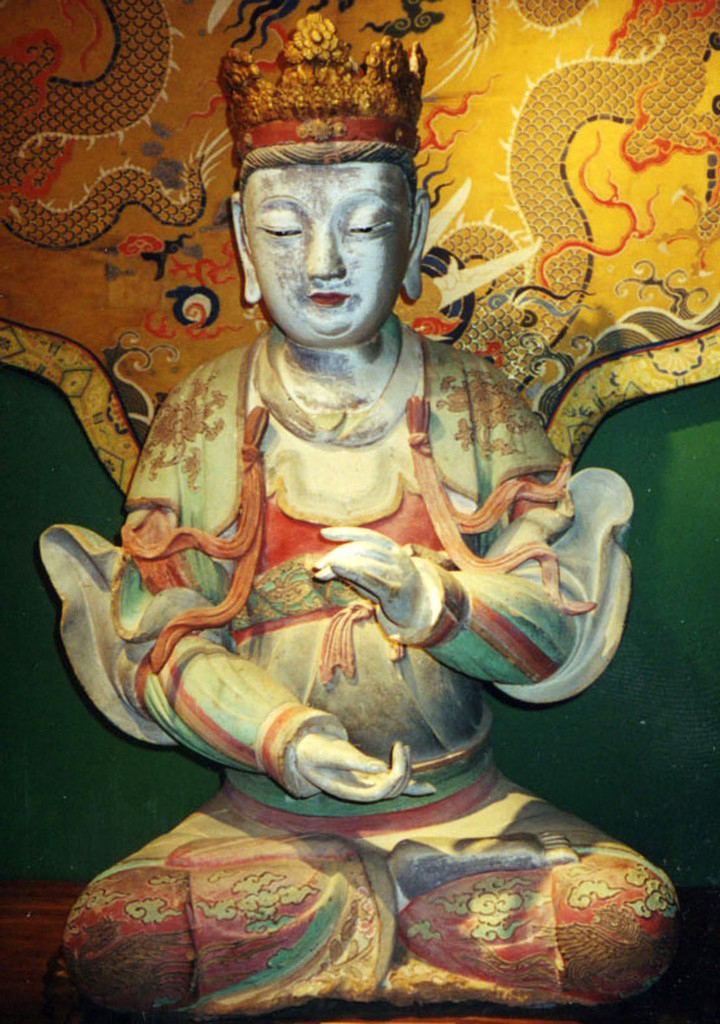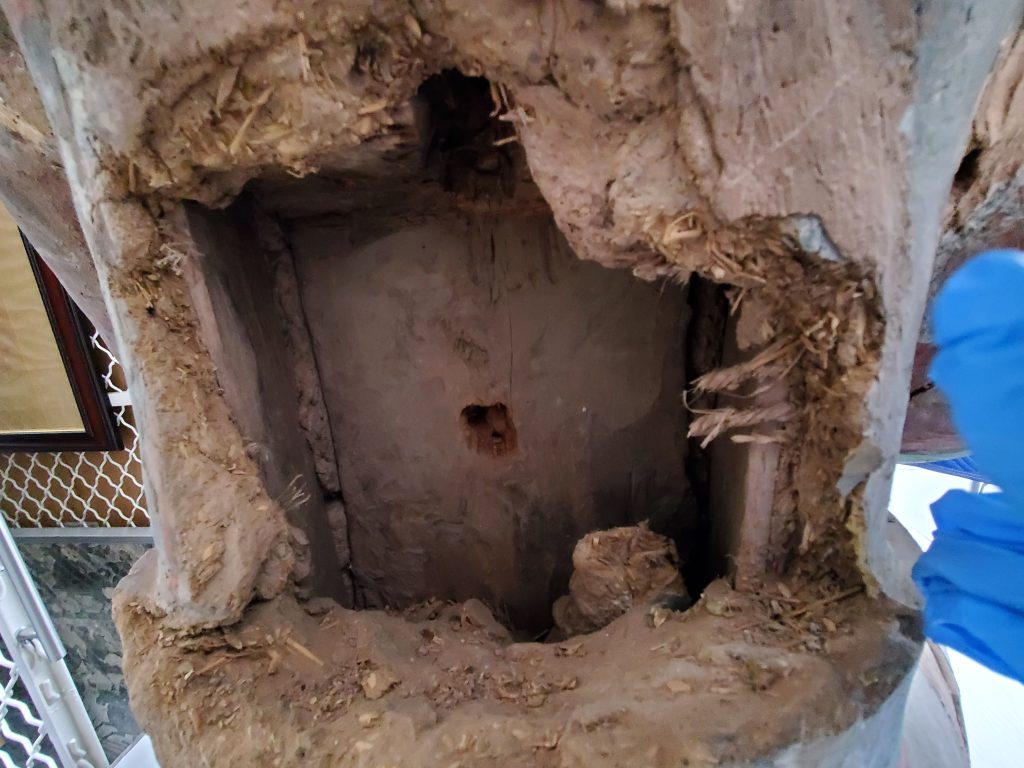Bodhisattva Statue
Bodhisattva Statue

Bodhisattva statue
Head: Ming Dynasty (1368-1644), Body: Liao Dynasty (907-1125)
Terracotta
37.5 x 24 x 18 in.
Buddhist China
2001.005
In Buddhist doctrine, bodhisattvas are benevolent beings with the potential to achieve enlightenment (nirvana), but instead delay nirvana to disseminate the teachings of the Buddha. This statue depicts one such being, distinguished- as they generally are- from the Buddha by an opulent crown and highly decorative gilded garments. Sculpted from terracotta, bits of grass and rock are exposed at the base and back of the sculpture likely due to the nature of its removal from its original context. On the torso clothing, there are patterns of lotus flowers with twisted branches. On the cloth over the legs, there are patterns of auspicious clouds, golden phoenix, and red flowers. According to the provenance record, this particular figure is likely Avalokitesvara (Chinese: Guanyin), a bodhisattva of compassion.1

Circumambulating the statue today, one makes a perhaps surprising discovery: a large open compartment, lined with wood panels, in the figure’s back. The space is currently empty, and one wonders what it once held. In India, both physical relics and Buddhist scriptures were deposited in Buddhist images like this one. This practice spread to other regions in Asia.2 Although the head and body of the statue appear cohesive, material analysis of both components revealed that the two may have distinct moments of creation, suggesting the sculpture may have been repaired in its lifetime.3 The head seems to have been created in China during the Ming Dynasty (1368-1644). However, material analysis suggests the body may have been made earlier, during the Liao Dynasty (907-1125).
Scholars have proposed more specific origins, “Liaoning province…perhaps present day Hebei and Inner Mongolia,” corresponding with the reign of the Liao Dynasty.4 The cool and dry climate of this geographical region might have preserved the paint until today. During these two periods in Chinese Buddhist history, art followed iconographic rules designating poses, colors, and proportions.5 The process of sculpting and painting bodhisattva sculptures was often a spiritual process. Practitioners considered the eyes of a sculpture to be particularly important, and a sculpture’s “eye opening,” dotting of the pupils or inserting gems or crystals into the eye socket, functioned as a birth for the figure.6
This bodhisattva has glass or crystal eyes that appear closed at eye-level, but widen as one kneels down, which is likely more akin to the original intended perspective. To further infuse a statue with life, monks would place sacred objects within them. Sacred texts known as sutras, precious stones, or relics would then be sealed within the chamber.7 The cavity of this bodhisattva almost surely once held artifacts with a strong likelihood of the inclusion of relics to imbue the work with sacred presence. Interred objects such as relics thus encouraged worship not as a symbol, but as the deity themself.
Emma Kane
Neuroscience and History of Art
Class of 2023
Hans Gao
Economics and Asian Studies
Class of 2022
Annotated Bibliography
Tythacott, Louise. The Lives of Chinese Objects : Buddhism, Imperialism and Display. New York, NY: Berghahn Books, Inc., 2011.
Tythacott discusses a series of bronze Ming Dynasty statues, known as the “Putuo Five,” depicting different bodhisattvas. The central and most ornate figure from the collection is Guanyin, as may also be the identity of the unknown bodhisattva statue discussed in this catalog entry. Tythacott describes the spiritual process of sculpting and breathing life into the statues, and proposes that they once held sacred texts and possibly relics. Tythacott additionally contends that the removal of the contents of these statues in the 19th century by British statues drained the living bodhisattvas of their vitality.
Hsu, Eileen Hsiang-ling . Monks in Glaze : Patronage, Kiln Origin, and Iconography of the Yixian Luohans. Boston: Brill, 2016.
In the synthesis part of this work, the author analyzed the influence of Tibetan Buddhism on the mainstream Chinese Buddhist art starting from the Yuan dynasty. The Yuan court established a strong political connection with the Tibet area and introduced many Tibetian Buddhist monks and craftsmen into its capital. This influence persisted in the following Ming dynasty. In relation to this work, the absence of the Lamanistic Buddhist iconographies and visual traits suggests that this work was not heavily influenced by this trend. This partially explains that previous owners dated this object to an earlier period (Liao dynasty).
Unknown Artist, Architectural Fitting, Earthenware, 1573, (British Museum)
https://www.britishmuseum.org/collection/object/A_1988-0728-1
A contemporaneous Ming Dynasty statue of the bodhisattva Guanyin currently in possession of the British Museum. The figure sits beneath a canopy embellished with precious gems and wears decorative robes, jewelry, and an opulent crown. The figure demonstrates the importance of context for Buddhist objects. Although beautiful on its own, this statue was once an architectural component of a Guanyin temple; it might have adorned a wall rather than an altar.
Bentor, Yael. “On the Indian Origins of the Tibetan Practice of Depositing Relics and Dhâranîs in Stûpas and Images.” Journal of the American Oriental Society, Vol. 115, No. 2 (Spring 1995): 248-261. https://www.jstor.org/stable/604668
Bentor discusses how the practice of depositing relics in Buddhist stûpas and images spread from India into Tibet. He emphasizes the significance of interring the Buddha’s words, immortalized through scripture, and the Buddha’s physical relics. Physical relics had a role in connecting the lay community to the Buddha, while written texts became somewhat of a proxy for the Buddha’s presence. Bentor further describes the actual practice of deposition of relics within images, which may bear certain similarities to our Bodhisattva statue and its now empty cavity.
